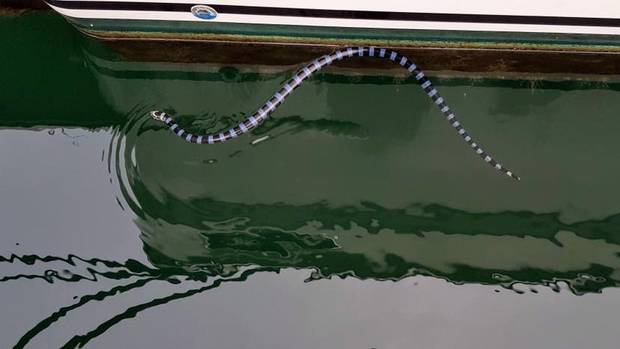
A sea krait spotted by people working on a boat in the Tauranga Bridge Marina on Sunday. At first glance, the creature was presumed to be a sea snake but later identified by experts as a banded sea krait.
Tauranga marine ecologist Professor Chris Battershill said such sightings were rare in New Zealand.
"Ordinarily they are from the Far North. To see one down here at this time of year is very unusual. But we have had a few weird things down here lately."
A sargassum fish and a lionfish, both usually found in tropical conditions, have also separately been spotted in Tauranga waters within the past few months.
"There has been a weird season with tropical species coming down with the current. It's very odd to see a sea krait here."
Prof Battershill said the sea krait was an endangered species and although it was highly venomous, there was more concern surrounding people interfering with the marine creature rather than the other way around.
There is no record of any person having been bitten by a sea krait in New Zealand. The positioning of venomous glands at the back of their mouth made it especially tricky for one to bite a person, Prof Battershill said.
"They are marvellous animals."
Prof Battershill said sea kraits were also inquisitive, and would likely swim up to a person's diving mask or goggles having seen their reflection, "which can be a little unnerving".
But the tropical species were not expected to last long in colder waters. Usually, when they were seen south of New Zealand's Far North, they were dead or close to it.
Prof Battershill said it was important to keep abreast of such sightings. While warmer sea temperatures could bring more tropical creatures to Tauranga, warmer conditions also had potential to inflict stress on established marine life dependent on cooler waters.
"We are living in a time of fast climate change in this country we need to be out there looking for those because it can change the whole ecosystem."
Department of Conservation's John Heaphy said it was possible such sightings would become more common due to global sea warming.
Heaphy said the tropical species was likely to be an "accidental arrival" having arrived with a current and if people see one, they should go to the Department of Conservation's website and fill in a form.
Sightings of sea kraits in New Zealand
Live specimens since 1988 - 3
Dead specimens since 1988 - 2
Source - Department of Conservation
Banded sea kraits facts
- Usually found in India, South-east Asia, New Guinea, Australia, and Pacific Islands.
- Bluish-grey above, yellow below, with about 35 prominent black bands
- Head is small and blunt
- Row of scales along the belly, more than half the width of the body
- Tail compressed sideways to form a paddle
Source - Department of Conservation
What should you do if you saw one?
Although sea snakes and kraits are occasional visitors to New Zealand's waters, they are considered a native species under the Wildlife Act 1953. It is therefore illegal to kill or harass a sea snake, or possess one or any part of one without a permit.
If you see one, stay well away and call 0800 DOC HOT.
Source - Department of Conservation












